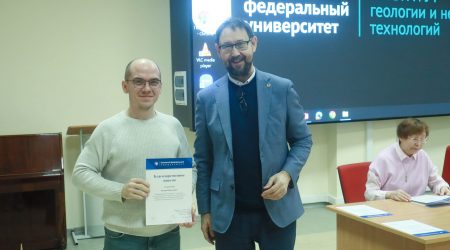How to enhance oil extraction – all about in-situ combustion
Below is a translation of an article from the latest issue of Neftegazovaya promyshlennost’ (Oil and Gas Industry) magazine.
Light oil in Russia is running out, and production requires the development of new technologies. In the old oil-producing region, Tatarstan, the focus is on developing high-viscosity oil fields and extending the life of mature fields. Solutions for regional oil production problems are being sought at Kazan Federal University.
For example, the Institute of Geology and Petroleum Technologies of Kazan Federal University is developing the method of in-situ combustion. We talked to Mikhail Varfolomeev and Alexander Bolotov about KFU’s current priorities and projects in this area.
What is in-situ combustion?
In-situ combustion is a technique in which oxygen is injected into the reservoir. This agent starts the combustion process, making the oil less viscous and easier to recover.
“One of the processes realized during in-situ combustion is called thermo-oxidative degradation: high-molecular-weight components of oil are converted to lower-molecular-weight components, and the oil becomes more mobile. The effect of combustion is several things. First, as the temperature rises, light hydrocarbons begin to, shall we say, vaporize: they move ahead of the combustion front and act as a solvent treatment.
Secondly, carbon dioxide is released. This itself is also a good extractant, so it can also further displace oil. Thirdly, a thermal effect occurs, where high temperature lowers the viscosity of oil and increases its mobility,” explains Lead Research Associate Alexander Bolotov.
The technology is suitable for fields with viscous oil. In addition, residual hydrocarbons can be recovered from mature fields with high water cut. Complex geological structure can be an obstacle to the use of the method.
“In order to apply the combustion technology, the thickness of the reservoir should be at least 3 meters. It is also desirable that the formation be as homogeneous as possible. If there are clay layers or zones where there is no oil, combustion will simply stop: it only occurs where there is oil, and clay layers create difficulties for the spreading the combustion front,” adds Head of the Department of Petroleum Engineering Mikhail Varfolomeev.
How in-situ combustion is enhanced at KFU
Theoretically, it is enough to pump air into the formation to start the in-situ combustion reaction. But in practice it is not so simple: there is a risk that the reaction will not start at all or the temperature will rise so high that the coking process will start right in the formation. The Laboratory of Enhanced Oil Recovery is working on the process.
“The first problem is the low temperature in the reservoir. In addition, there are heterogeneous formations: there are high- and low-permeability zones, and in these cases combustion may not start and spread very efficiently. To avoid this, special additives – initiators – are added. These are chemical reagents that allow the combustion process to start in the formation at lower temperatures. The second additive is catalysts, which make it possible to set the process in motion evenly and efficiently and thus increase the radius of coverage of the field of such technology,” explains Dr Varfolomeev.
However, before using reagents, scientists determine whether an in-situ combustion reaction is possible under the given conditions. The laboratory equipment helps the specialists to make the necessary calculations, assess risks and predict possible complications.
“In our laboratory, we have a physical model of a reservoir. It is a large combustion pipe which is equipped with various sensors. We use them to monitor changes in the temperature front and pressure. At the output, we analyze all the compositions: both the gases coming out and the synthetic oil being produced. After that, we look at what changes have occurred with the rock. All this allows us to simulate processes that in real conditions occur at a depth of several kilometers,” says Alexander Bolotov.
“The result of the study is a set of parameters. With their help, we can calculate, for example, how much air is needed; whether it is necessary to use some additional reagents, such as catalysts, to initiate the combustion process or to make the front move evenly. There are nuances here too: dry or wet combustion can be used. This choice is quite important because water has a slightly different heat capacity. Thus, we can increase or decrease the thermal effect,” he continues.
Based on this, financial calculations are made to make recovery profitable.
“In terms of equipment, capital expenditures are the compressors needed to pump air. In terms of economic efficiency, we look at how much air needs to be pumped to produce 1 ton of oil. If this ratio is low, i.e. not much air needs to be injected, then the technology is economically efficient. In fact, it has great potential, because air is a free reagent,” comments Dr Varfolomeev.
Kazan Federal University is also working on the development of effective reagents to maximize the use of the method. Significant progress has been made in reducing the temperature for starting the combustion of heavy oils: the process with the help of catalysts can be started at 200 ° C, which is 50 to 100 degrees lower than the existing process.
Using the technology in the field
Based on local conditions, in-situ combustion can increase recovery ratio by 5 to 15 percent. It has been introduced in India and China, and there is a big project in Romania. The Kazanian technology has been tested in China, Oman, and Uzbekistan. Big clients are showing interest in Russia, including Lukoil, Tatneft, and Zarubezhneft.
The technology is currently aimed at decreasing costs for hard-to-recover and unprofitable reserves. It has huge potential in case of Bazhenov formation – which is characterized by a high ratio of oil-bearing rocks. It’s also pertinent for old oil regions where deposits are significantly depleted.
However, the combustion also has more remote prospects, such as hydrogen recovery.
“Simultaneous recovery of oil and hydrogen is a prospective area. There are new research works on underground hydrogen recovery, and we are looking forward in this direction. Under certain conditions, productive hydrogen can be generated. It can be recovered it hydrocarbons,” concludes Bolotov.










